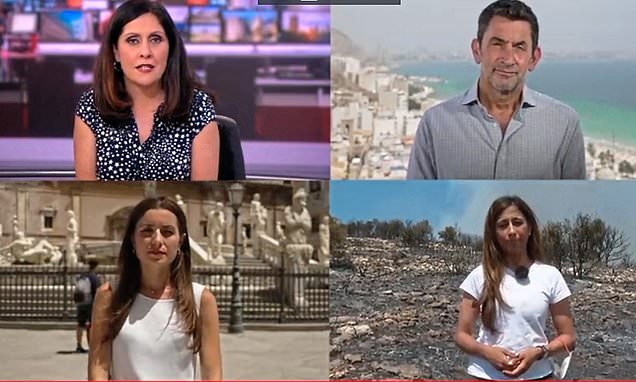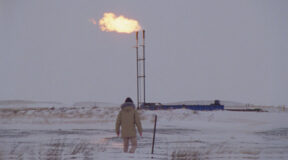ROSS CLARK: Yes, climate change is real. But the prophets of doom ignore some very inconvenient truths…
Was there anything more ludicrous during last week’s European heatwave and worries about global warming than the BBC’s climate editor travelling from London to Spain (and back again) to report on the high temperatures?
Addressing viewers from Alicante, Justin Rowlatt, the Corporation’s prophet of doom, said: ‘We’re getting the blast of the heat today in Spain, it’s going to go across into Italy. It’s already very hot in Italy but it’s going to get hotter there, and finally it will end in Greece. All accentuated, exaggerated by the effects of climate change.’
Lucky for some, many viewers may have thought, as they sat in cooler Britain. In southern England, daytime temperatures did peak last week at 25C but for much of the country, temperatures struggled to push beyond 17C, well below the seasonal average. It is not unusual in the summer for the Mediterranean to be hot and Britain a lot cooler. That is, after all, why millions go there on holiday every year.
Yet it seems we are no longer allowed to enjoy the prospect of a hot summer’s day, whether in Britain or the Med. Sun-kissed beaches, for Rowlatt and his ilk, are a portent of doom and a symptom of the fast-gathering ‘climate emergency’.
What’s more, we are encouraged to feel guilty – partly because of all those carbon emissions spewed out by holiday jets.
Armageddon: The BBC’s wall-to-wall reporting of the European heatwave, with Justin Rowlatt, top right
Thus the irony – and hypocrisy – of Rowlatt taking a return trip (believed to be by gas-guzzling plane) to Spain when he could have delivered the same message from London, or the BBC could have used one of its many Spain-based correspondents.
It must be stressed that climate change is a problem but there is evidence to suggest it is not the apocalypse that the eco-lobby wants us to believe. True, the incidence of heatwaves has increased in recent decades as the world has warmed. Mean maximum daily summer temperatures in Britain, for example, have risen by one degree Celsius in the past 60 years – with most of that increase occurring between the late 1980s and early 2000s.
However, the trend in summer temperatures has been flatter in the two decades since, according to the State of the Climate Report published by the Royal Meteorological Society. In Spain, according to a study in the latest Intergovernmental Panel on Climate Change report, maximum daily temperatures in summer have increased by a little more – by 1.9C since 1960. But none of this justifies the hyperbole served up over the past week. There is nothing unprecedented about the temperatures recorded in Europe. The continent’s record of 48.8C – in Sicily two years ago – has not been passed nor has the second-highest temperature (48C in 1977).
Further afield, the global high temperature record – 56.7C in Death Valley, California, in 1913 – has not been broken.
Just as with Covid, fear is being used to try to convince us that the heat is more dramatic than it is. An analysis of the weather maps shown on TV over the past week proves this. During last year’s heatwave, such maps showed areas experiencing 40C in deep red. Now, these areas have turned a lurid pink – or white. Even Britain was depicted on some maps as red.
Another move has been to quote ground temperatures, rather than air temperatures. During heatwaves, the temperature of dry, dusty ground can reach 60C – which can be up to 20C warmer than air temperatures. Film of burning trees, too, sends the message promulgated by climate activist Greta Thunberg that ‘the world is on fire’. Yet, according to data from the European Forest Fire Information System, 2023, so far, has been an average year for forest fires in Europe, with a total of 150,000 hectares burned.
In the worst years, 500,000 hectares have burned by the middle of July. Besides, wildfires have, for millennia, been a natural part of the ecosystem in many climates. Some plants – called pyrophytes – need fire in order to germinate.
Last Tuesday, Sky News’ Kirsty McCabe told viewers ready to holiday in the Med: ‘You won’t be able to have the traditional beach holiday, you want to be staying inside.’
ROSS CLARK: How many times were we told during the past week that last year’s heatwave killed 60,000 people in Europe? (Pictured: Firefighters in a burning pine forest in La Teste de Buch, near Arcachon, southwestern France, 2022)
Actually, temperatures at the coast, as usual, were more moderate than the hotspots inland. In the Algarve, at 3pm that day, they ranged from 21C to 29C, the Costa Brava 27C to 29C, and the Costa del Sol 27C to 31C. There was no reason why anyone should not have been able to enjoy the beach as usual.
How many times were we told during the past week that last year’s heatwave killed 60,000 people in Europe? The figure is derived from a study by the Barcelona Institute for Global Health, published in the journal Nature Medicine last week.
And yes, it is true that hot spells tend to see ‘excess deaths’ above the average. But what the reporting omitted was that, each year, deaths from the heat are vastly outnumbered by deaths from cold weather – and that cold extremes are falling as the Earth warms.
The most comprehensive study of temperature-related deaths globally was made by Monash University, Australia, in 2021. It concluded that five million deaths annually could be attributed in some way to extreme temperatures (with other underlying causes) but that deaths from extreme cold outnumbered those from extreme heat by more than ten to one. This was true even in Africa.
Moreover, while deaths from high temperatures increased by 0.21 per cent between 2000 and 2019, deaths from extreme cold fell by 0.51 per cent over the same period. The net result, as the world warms and we experience fewer cold temperature extremes, is that the world is seeing fewer temperature-related deaths by the year. This point is rarely made because it doesn’t fit with the fear-mongers’ narrative that we are headed for climatic Armageddon – and that it is all our fault.
ROSS CLARK: Indeed, as temperatures in Spain have increased, the country’s excess death-rate has gone in the other direction (Pictured: Valencia, Spain)
Sure, climate change is real and the world is seeing a greater frequency of extreme high temperatures. But, no, the world is not becoming unliveable. It was Spain, after all, which gave us the concept of a siesta to avoid the hottest part of the day. Air conditioning, storm warnings, flood defences and technological advances all help mankind deal with extreme weather.
Indeed, as temperatures in Spain have increased, the country’s excess death-rate has gone in the other direction. Similarly, in New York, where summers have for centuries been known for their oppressive temperatures. Since the 1960s, deaths attributable to heat have fallen by two-thirds.
You might expect higher than normal temperatures would be a prerequisite for those preaching climate catastrophe. But, according to the BBC, even this year’s below-average July temperatures in Britain are a symptom of man-made climate change.
Ten days ago, in an online explainer – entitled Where Has The UK Summer Gone? – BBC weather presenter Ben Rich wrote that our current ‘dropped temperatures’ and more rainfall are due to a blocking pattern in the air circulation over the North Atlantic. Even so, he concluded that ‘some studies suggest climate change might make blocked patterns more common’.
In other words, we all risk going to hell in a handcart – or, in Justin Rowlatt’s case, gallivanting 1,800 miles there and back by jet.
Source: Read Full Article








